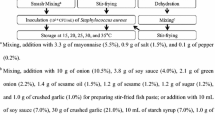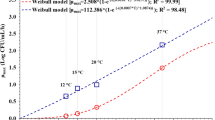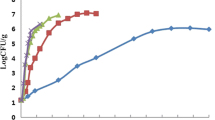Abstract
Egg products are widely consumed in Korea and continue to be associated with risks of Staphylococcus aureus-induced food poisoning. This prompted the development of predictive mathematical models to understand growth kinetics of S. aureus in egg products in order to improve the production of domestic food items. Egg products were inoculated with S. aureus and observe S. aureus growth. The growth kinetics of S. aureus was used to calculate lag-phase duration (LPD) and maximum specific growth rate (µmax) using Baranyi model as the primary growth model. The secondary models provided predicted values for the temperature changes and were created using the polynomial equation for LPD and a square root model for µmax. In addition, root mean square errors (RMSE) were analyzed to evaluate the suitability of the mathematical models. The developed models demonstrated 0.16–0.27 RMSE, suggesting that models properly represented the actual growth of S. aureus in egg products.




Similar content being viewed by others
References
Baranyi J, Roberts TA. A dynamic approach to prediction bacterial growth in food. Int. J. Food Microbiol. 23: 277–294 (1994)
Baranyi J, Ross T, Roberts TA, MeMeekin TA. Effect of parameterization on the performance of empirical models used in ‘predictive microbiology’. Food Microbiol. 13: 83–91 (1996)
Bharathi S, Ramesh MN, Varadaraj MC. Predicting the behavioural pattern of Escherichia coli in minimally processed vegetables. Food Control. 12: 275–284 (2001)
Buchanan RL, Whiting RC, Damert WC. When is simple good enough: a comparison of the Gompertz, Baranyi, and three-phase linear models for fitting bacterial growth curves. Food Microbiol. 14: 313–326 (1997)
Cho JI, Lee SH, Lim JS, Kwak HS, Hwang IG. Development of a Predictive model describing the growth of Listeria Monocytogenes in fresh cut vegetable. J. Food Hyg. Saf. 26: 25–30 (2011)
Cho JI, Lee SH, Lim JS, Kwak HS, Hwang IG. Predictive mathematical model for the growth kinetics of Listeria monocytogenes on smoked salmon. J. Food Hyg. Saf. 26: 120–124 (2011)
Delignette-Muller ML, Rosso L, Flandrois JP. Accuracy of microbial growth predictions with square root and polynomial models. Int. J. Food Microbiol. 27: 139–146 (1995)
Dinges MM, Orwin PM, Schlievert PM. Exotoxins of Staphylococcus aureus. Clin. Microbiol Rev. 13: 16–34 (2000)
Duffy LL, Vanderline PB, Grau FH. Growth of Listeria monocytogenes on vaccum-packed cooked meats: effects of pH, aw, nitrite and ascorbate. Int. J. Food Microbiol. 23: 377–390 (1994)
Grijspeerdt K, Vanrolleghem P. Estimating the parameters of the Baranyi model for bacterial growth. Food Microbiol. 16: 593–605 (1999)
Hong SH, Park NY, Jo HJ, Ro EY, Ko YM, Na YJ, Park KC, Choi BG, Min KJ, Lee JK, Moon JS, Yoon KS. Risk ranking determination of combination of foodborne pathogens and livestock or livestock products. J. Food Hyg. Saf. 30: 1–12 (2015)
Jo HJ, Choi BG, Yan W, Moon JS, Kim YJ, Yoon KS. Microbiological quality and growth and survival of foodborne pathogens in ready-to-eat egg products. J. Food Hyg. Saf. 30: 178–188 (2015)
Jones FT, Rives DV, Carey JB. Salmonella contamination in commercial eggs and an egg production facility. Poult. Sci. 74: 753–757 (1995)
Kadariya J, Smith TC, Thapaliya D. Staphylococcus aureus and staphylococcal food-borne disease: an ongoing challenge in public health. Biomed. Res. Int., 2014:827–965. https://doi.org/10.1155/2014/827965 (2014)
Kang HS, Ha SD, Jeong SW, Jang M, Kim JC. Predictive modeling of Staphylococcus aureus growth on Gwamegi (semidry Pacific saury) as a function of temperature. J. Korean Soc. Appl. Biol. Chem. 56: 731–738 (2013)
Kang KA, Kim YW, Yoon KS. Development of Predictive growth models for Staphylococcus aureus and Bacillus cereus on various food matrices consisting of ready-to-eat (RTE) foods. Korean J. Food Sci. Anim. Resour. 30: 730–738 (2010)
Kim KH, Park BY, Oh MH, Kim HW. Effect of storage temperature on growth and toxin production of Staphylococcus aureus in milk. Korean J. Dairy Sci. Technol. 32: 105–109 (2014)
Kim KM, Lee HY, Moon JS, Kim YJ, Heo EJ, Park HJ, Yoon Yh. Mathematical models to predict Staphylococcus aureus growth on processed cheeses. J. Food Hyg. Saf. 28: 217–221 (2013)
McClure PJ, Beaumont AL, Sutherland JP, Roberts TA. Predictive modeling of growth of Listeria monocytogenes: the effect on growth of NACL, pH, storage temperature and sodium nitrate. Int. J. Food Microbiol. 34: 221–232 (1997)
Moon HJ, Lim JG, Yoon KS. Comparative study of change in Salmonella Enteritidis and Salmonella Typhimurium populations in egg white and yolk. J. Food Hyg. Saf. 31: 342–348 (2016)
Pal A, Libuza TP, Diez-Gonzalez F. Comparison of primary predictive models to study the growth of Listeria monocytogenes at low temperatures in liquid cultures and selection of fastest growing ribotypes in meat and turkey product slurries. J. Food Microbiol. 25: 460–470 (2008)
Park HS, Bahk GJ, Park KH, Pak JY, Ryu K. Predictive model for Growth of Staphylococcus aureus in suyuk. Korean J. Food Sci. Anim. Resour. 30: 487–494 (2010)
Park HS, Kim MY, Jeong HS, park KH, Ryu K. Development of a predictive growth model of Staphylococcus aureus and shelf-life estimation of cooked mung bean sprouts served in school foodservice operations. J. Korean Soc Food Sci Nutr. 38: 1618–1624 (2009)
Park SY, Choi JW, Chung DH, Kim MG, Lee KH, Kim KS, Bahk GJ, Bae DH, Park SK, Kim KY, Kim CH, Ha SD. Development of a predictive mathematical model for the growth kinetics of Listeria monocytogenes in sesame leaves. Food Sci Biotechnol. 16: 238–242 (2007)
Ratkowsky DA, Olley J, McMeekin TA, Ball A. Relationship between temperature and growth rate of bacterial cultures. J. Bacteriol. 149: 1–5(1982)
Ratkowsky DA, Ross T. Modelling the bacterial growth/no growth interface. Lett Appl Microbiol. 20: 29-33 (1995)
Ross T. Belehradek-type models. J. Ind. Microbiol. Biotechnol. 12: 180–189 (1993)
Ross T. Indices for performance evaluation of predictive model in food microbiology. J. Appl. Bacteriol. 81: 501–508 (1996)
Ross T. Predictive food microbiology models in the meat industry. Meat and Livestock Australia, Sydney, Australia. pp. 196 (1999)
Van Impe JF, Poschet F, Geeraerd AH, Vereecken KM. Towards a novel class of predictive microbial growth models. Int. J. Food Microbiol. 100: 97–105 (2005)
Walls I, Scott VN. Use of predictive microbiology in microbial food safety risk assessment. Int. J. Food Microbiol. 36: 97–102(1997)
Wieneke AA, Roberts D, Gilbert RJ. Staphylococcal food poisoning in the United Kingdom 1969-90. Epidemiol. Infect. 110: 519–531 (1993)
Yilmaz MT. Identifiability of Baranyi model and comparison with empirical models in predicting effect of essential oils on growth of Salmonella typhimurium in rainbow trout stored under aerobic, modified atmosphere and vacuum packed conditions. Afr J Biotechnol. 10: 7468–7479 (2011)
Yoon KS. Application of Korea pathogen modeling program (KPMP) for food safety management. Food Sci Ind. 46: 2–12 (2013)
Yoon YH. Principle theory and application of predictive microbiology. Food sci Ind. 43: 70–74 (2010)
Yun HJ, Kim JH, Park KH, Ryu KY, Kim BS. Development and validation of predictive models of Escherichia coli O157:H7 growth in paprika. J. Food Hyg. Saf. 28: 168–173(2013)
Acknowledgements
This research was supported by the Korea Ministry of Food and Drug Safety (15161MFDS647). Later, this study will be used as a scientific basis for establishing food microbiological standards.
Author information
Authors and Affiliations
Corresponding author
Additional information
Publisher's Note
Springer Nature remains neutral with regard to jurisdictional claims in published maps and institutional affiliations.
Rights and permissions
About this article
Cite this article
Choi, WS., Son, N., Cho, JI. et al. Predictive model of Staphylococcus aureus growth on egg products. Food Sci Biotechnol 28, 913–922 (2019). https://doi.org/10.1007/s10068-018-0529-4
Received:
Revised:
Accepted:
Published:
Issue Date:
DOI: https://doi.org/10.1007/s10068-018-0529-4




